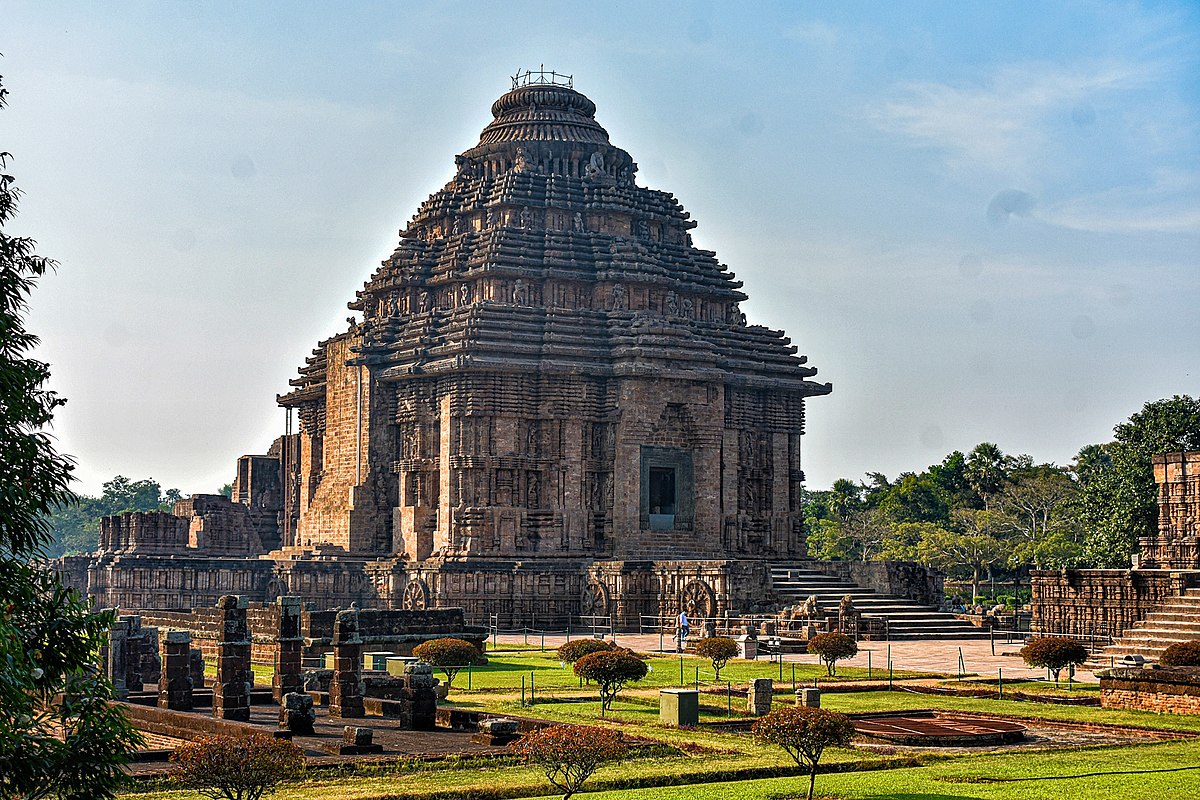Konark Sun Temple
The Sun Temple at Konark, an architectural marvel from the 13th century, stands as a testament to the artistic brilliance of the Kalinga dynasty. Dedicated to the Sun God, this UNESCO World Heritage Site mesmerizes visitors with its grand design and rich cultural heritage.

Unveiling the Mysteries of Sun Temple Konark: A Marvel of Ancient Indian Architecture
| Deity: | Surya (Sun God) |
| State – City: | Konark, Odisha |
| Best time to visit | October-February |
| Open Hours | 6:00 AM–8:00 PM |
| Popular festival | Konark Dance Festival |
FAQ
Where is Konark Sun Temple located?
Konark, Odisha.
What is the origin or historical significance of the Konark Sun Temple?
The Sun Temple at Konark, located on the eastern coast of India, is a monumental example of 13th-century temple architecture. Built during the reign of King Narasimhadeva I (1238-1264 AD) of the Eastern Ganga dynasty, the temple reflects the zenith of Kalingan artistry and the political and spiritual power of the time. It is believed that the temple was constructed to celebrate the king’s victory over Muslim invaders and to honor Surya, the Sun God. The temple also holds mythological significance, as legend has it that it was built by Samba, the son of Lord Krishna, who was cured of leprosy by Surya after 12 years of penance.
Who built or upgraded the Konark Sun Temple?
The Konark Sun Temple was built by King Narasimhadeva I of the Eastern Ganga dynasty. The temple is designed as a colossal chariot of the Sun God, Surya, complete with twelve pairs of intricately carved stone wheels, each about 3 meters in diameter, and seven horses. The chariot-like structure symbolizes the movement of the sun across the heavens. The architectural brilliance of the temple lies in its precise alignment with the cardinal directions and the intricate carvings that adorn its walls, depicting scenes from daily life, mythology, and the natural world.
What are the cultural or mythological references associated with the temple?
The Sun Temple is steeped in mythology and cultural significance. According to legend, the temple was built by Samba, the son of Lord Krishna, who was cured of leprosy by the Sun God, Surya. This mythological association adds to the temple’s spiritual aura. Additionally, the temple’s location at the mouth of the Chandrabhaga River (now dried up) is considered a site of divine healing, further enhancing its religious significance. The temple also served as a key site for the diffusion of the Surya cult, bridging Brahmanic and Tantric belief systems.
What are the unique points about the Konark Sun Temple?
The Sun Temple is unique for several reasons:
- Architectural Design: The temple is designed to resemble a giant chariot, symbolizing the sun’s journey across the sky.
- Sundials: The wheels of the temple function as sundials, allowing precise calculation of time based on the shadows they cast.
- Sculptural Narrative: The temple walls are adorned with a wealth of sculptures, including mythological scenes, which depict the life and beliefs of 13th-century society.
- Mythological Significance: The temple’s association with Samba’s healing by Surya and its connection to the Surya cult make it a site of deep spiritual importance.
Why is the Konark Sun Temple famous?
The Sun Temple is renowned for its architectural grandeur, historical significance, and spiritual importance. It is one of India’s most famous temples and is recognized as a UNESCO World Heritage Site. Visitors are drawn to the temple not only for its religious significance but also for its stunning architecture and intricate carvings that offer a glimpse into the life and culture of 13th-century India. The annual Chandrabhaga Fair is another major attraction, drawing pilgrims and tourists from around the world.
What is unique about the temple’s architecture?
The Sun Temple’s architecture is a masterpiece of Kalingan style, characterized by its chariot-like design with twelve pairs of intricately carved wheels and seven horses. The temple’s orientation ensures that the first rays of the morning sun illuminate the sanctum, symbolizing the temple’s dedication to the Sun God.
The intricate carvings on the temple walls, depicting everything from daily life to divine beings, are a testament to the craftsmanship and artistic vision of the temple’s builders. The temple also features an audience hall (jahamogana), a dance hall (natmandir), and a sanctuary (vimana), showcasing a diverse range of architectural elements.
When is the best time to visit the Konark Sun Temple?
The best time to visit the Sun Temple is between October and March, when the weather is pleasant and ideal for exploring the temple complex. Visitors can expect to be awed by the temple’s architectural brilliance, intricate carvings, and the spiritual atmosphere that pervades the site. The annual Chandrabhaga Fair, held in February, is a particularly vibrant time to visit, offering a unique cultural experience.
How can one reach the Konark Sun Temple?
The Sun Temple is located in Konark, Odisha, on the eastern coast of India. The nearest airport is Biju Patnaik International Airport in Bhubaneswar, about 65 kilometers away. From Bhubaneswar, visitors can hire a taxi or take a bus to Konark. The nearest railway station is Puri, approximately 35 kilometers away, from where taxis and buses are available to reach the temple.
The Sun Temple at Konark is not just an architectural masterpiece but a profound symbol of India’s rich cultural and spiritual heritage. Its intricate carvings, mythological significance, and innovative design reflect the artistic and religious aspirations of the 13th century. As a UNESCO World Heritage Site, the temple continues to inspire awe and reverence, drawing visitors from around the world to witness the enduring legacy of devotion, craftsmanship, and historical grandeur.






